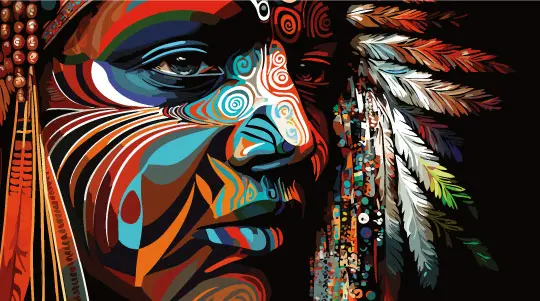RISE MODULE: Indigenous Peoples' Day
OVERVIEW & HISTORY
Indigenous Peoples' Day is celebrated in the United States annually on the second Monday of October to honor the cultures and histories of America's Indigenous people. The holiday is recognized on the same day as Columbus Day as counter-celebration against the federal holiday honoring Italian explorer Christopher Columbus. Many states and cities are choosing to commemorate the achievements and contributions of Indigenous people and groups and place less focus on Columbus, who is a representation of the colonization of the Western Hemisphere by European settlers.
Celebrations for Indigenous Peoples' Day date back to 1977, after the International Conference on Discrimination Against Indigenous Populations in the Americas sponsored by the United Nations. To coincide with the 500th anniversary of Columbus' arrival in the Americas, Berkeley, California, instituted Indigenous Peoples' Day in 1992. As of 2022, 20 states—ten via proclamation and ten as a state holiday—and over 100 cities observe Indigenous Peoples' Day or similarly named holiday on the same day. Combatting the idea that Columbus discovered uninhabited lands is an important element of promoting Indigenous Peoples' Day as a replacement for Columbus Day. The day asks us to recognize the people and cultures that lived in North America prior to European settlement and the ways in which their cultures have endured and survived.
Celebrations for Indigenous Peoples' Day date back to 1977, after the International Conference on Discrimination Against Indigenous Populations in the Americas sponsored by the United Nations.
One aspect of that survival has been the sport of lacrosse, which has grown in popularity across much of the United States and Canada. This sport can be traced back to the Indigenous peoples' of North America, who played variations of the game as early as the 12th century. While the sport was known by many names, it is known by most in the Indigenous community as the “Creator's Game,” since it holds significant cultural and spiritual importance for native peoples'. The colonization of the continent in the 17th century led to lacrosse (French name) being adopted by settlers and evolving into the version of the game played today. It has become a rapidly growing sport in North America, with teams formed at young ages in schools to the development of multiple professional and semi-professional professional leagues.
Despite founding the popular sport of lacrosse, the legacy of Native American representation in sport has been a complicated one. Not only are many persons are unaware of Native Americans contributions to the sport of lacrosse, but there has also been a long history of using the Native American references and caricatures as names for team mascots and logos. While several teams have taken steps to address this practice in recent years, the tradition has overshadowed some of the constructive attempts to instill a more educated and enlightened understanding of Native American traditions and practices. Some teams and fans still engage in “the chop” and dress in traditional Native American gear at sporting events and other occasions, demonstrating a lack of respect and understanding for what these symbols mean and the value they carry to Indigenous people.

Despite these enduring challenges, many Indigenous athletes have achieved great success in sports. On a global stage, Jim Thorpe, a member of the Sac and Fox Nation, was the first Native American to win an Olympic gold medal for the United States. He was a star athlete in multiple sports, including track and field and professional football, baseball, and basketball. Thorpe was ranked as the “greatest athlete” of the first 50 years of the 20th century by the Associated Press.
It is also important to note that many Indigenous athletes use their platform of sport to advocate for their communities. The Thompson brothers, players from the Onondaga Nation, are known through the professional lacrosse community for their talent in the game, and now use their platform to advocate for the education of native communities. Rosalie Fish, a runner and a member of the Cowlitz Tribe, paints a red hand across her face during competition to raise awareness of the hundreds of missing and murdered Indigenous women. These athletes embody the power of athlete activism and illustrate that sport and its platform can be a vehicle for change.
CONVERSATION STARTERS:
- Engage with friends, family, and colleagues in discussions about early U.S. History regarding this land's original inhabitants, and the current presence of American Indigenous groups:
- What tribes exist near where you were raised?
- Who were the first Native/American Indian and Alaskan Natives to join Congress?
- Have you or someone you know spent time participating in tribal government?
- Engage in critical dialogue around the United States' complicated history of Indigenous communities during the European colonization of the Americas. Also, discuss current discrimination Indigenous people face. For example:
- Acknowledge the impact of the violent history of earlier colonization of the Americas on Indigenous groups and demystify falsehoods surrounding the discovery of this land.
- Has your organization researched the tribe or tribes that originally inhabited its land?
- As an organization, are we supporting or celebrating colonial-based holidays in a manner that may be disrespectful towards indigenous colleagues?
ACTION STEPS
- Discuss the things you read, listen to, or watch regarding the history and discrimination of Indigenous groups and people.
- Educate yourself and your loved ones on the cultures and traditions of local tribes.
- Be critical of yourself, your own communities, organizations, departments, and teams. Ask if there are policies and practices in place marginalizing Indigenous peoples' in the workplace.
- Collaborate with local tribes to develop a land acknowledgement.
Our
Partners
Stay
In Touch
Follow us on social media.